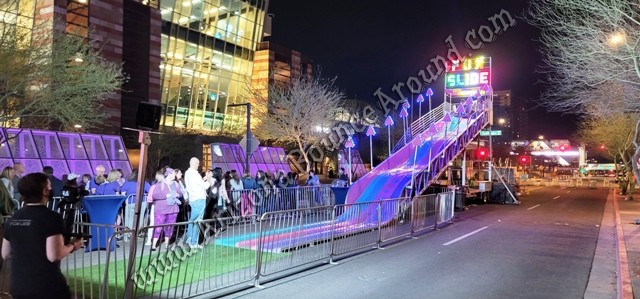Your Wish List
1
LED Dance Floor Rental2
Professional 850 WATT Fog Machine3
LED Park Bench Rental - Battery Operated4
Giant Slip N Slide Rental5
Fiberglass Fun Slide Rental6
19' x 19' Circus World Playland7
Mechanical Bull Rental with Western Ring8
Snowman Maze - 40' x 40'9
51' Skyscraper Water Slide10
21 x 18 Christmas Roundabout Playland11
Fiesta Playland - 19' x 19'
Call us today 480-874-3470
History of the Fun Slide
 Carnival-Style Fun Slides: Origins and Evolution
Carnival-Style Fun Slides: Origins and EvolutionEarly Funhouse and Park Slides (Early 20th Century)
Slides first appeared as attractions in early 1900s funhouses and amusement parks. Coney Island’s Steeplechase and other parks featured tall wooden slides (“giant slides”) inside funhouse pavilions, often two stories high. These were typically smooth, highly polished hardwood slides, and riders used burlap mats (“gunny sacks”) to protect themselves from friction burns
For example, Baltimore’s Glen Echo park in the 1930s installed a 90-foot polished maple slide; riders “sat on burlap sacks” to slide down
These early slides had a few lanes and big drops, but the foundation of sliding on coarse mats was set. By the mid-20th century, many amusement parks added similar wooden slides as standalone attractions, a precursor to the modern multi-lane carnival slide.
Post-War Outdoor Slides (1950s–1970s)
In the post‑war period, the classic carnival “fun slide” became a popular midway attraction at state fairs and local amusement parks. In 1965 a carnival worker named Fred Pittroff saw a 20‑foot slide at Santa Cruz and built a 40‑foot version the next week. He refined it using corrugated steel with grooves (rather than ridges) so riders would glide safely
Pittroff and his wife went on to build over 40 such slides across the United States (and one in Australia)
The iconic yellow Minnesota State Fair slide (opened in 1969) is still operated by their family and draws 200,000 riders annually
Other state fairs adopted the ride as well (e.g. Wisconsin’s state fair). Even modest parks built slides: Camden Park (West Virginia) installed a tall multi‑lane slide in the early 1980s where riders climbed a stair tower and “slid down one of the lanes on a burlap mat”
These post‑war slides generally had 3–6 lanes, plywood or steel troughs painted bright colors, and used burlap or later felt mats to reduce friction. (Over time even felt or carpet mats began to replace burlap on many slides for comfort
International Expansion (1970s–1990s)
In Europe and the UK, similar multi-lane slides gained popularity from the 1970s onward. UK manufacturer Bennett built over 100 “Astroglide” giant slides between 1970–1978 – making it Europe’s largest slide maker in that era
These Bennett slides featured 4, 6 or 9 painted fiberglass lanes and used burlap mats just like their American counterparts. After Bennett dissolved in the 1980s, Harry Steer Engineering (UK) continued producing giant slides using Bennett’s design
Giant slides (often called “Rutsch’n” or “Helter Skelter” slides in German fairs) became staples at events like Oktoberfest. For example, the multi-colored Bavarian-style slide shown above was a feature of Munich’s folk festivals, reflecting this European tradition. In these decades, slide designs from the US and UK diffused worldwide: by the 1980s and 90s many traveling carnivals had at least one multi-lane slide, and parks from Australia to Canada installed them (the Minnesota builders sold one to an Australian fair
Modern Slides and Innovations (2000s–Present)
In recent decades, carnival slides have been further refined for safety and durability. Many now use heavy-gauge galvanized steel frames and corrugated metal slide decks. For instance, Ray Cammack Shows (an American carnival company) rebuilt the Timber Mountain Slide at the Los Angeles Fair in 2012 using steel panels and hot-dip galvanizing for long life
Riders still sit on burlap or synthetic “gunny sack” mats for sliding
Other innovations include textured grooves in the slide surface (to slow riders) and more gentle hump profiles to avoid hard landings
Slides are painted with high-durability epoxy paints (as in Minnesota, where yellow paint was chosen because it stays cooler in sun
Even the mats evolved: many slides replaced traditional burlap with felt pads when burlap became scarce. This is what rental companies like Arizona Bounce Around in Phoenix, Arizona provides with all Fun Slide rentals
Overall, the large carnival slide remains largely the same experience — a stair climb and a “bumpy” descent on a sack — but built with stronger materials and smoother rides than the early wooden versions.
Key Manufacturers and Innovations
Bennett (UK): Produced the Astroglide multi-lane slide in the 1970s, delivering over 100 units across Europe
Harry Steer Engineering (UK): After Bennett closed, this company built new giant slides in the 1980s–90s using the same designs
Fred & Beverly Pittroff (USA): Built the first modern outdoor carnival slide in 1965 (inspired by Santa Cruz) and perfected the corrugated-steel design
They installed over 40 slides nationwide and one in Australia during the 1960s–80s
Sky-Slide International (USA): A California manufacturer that made early fiberglass slides, including the 45-foot yellow slide at Detroit’s Belle Isle (opened 1968)
Ray Cammack Shows (USA): A carnival operator active since 1963 that built large permanent slides (e.g. the 130-foot Timber Mountain Slide) using modern steel construction
These companies and others drove improvements in materials (from wood to fiberglass and steel) and construction (corrugated decks, galvanizing, epoxy paints) while keeping the classic burlap-mat sliding experience at the heart of the ride